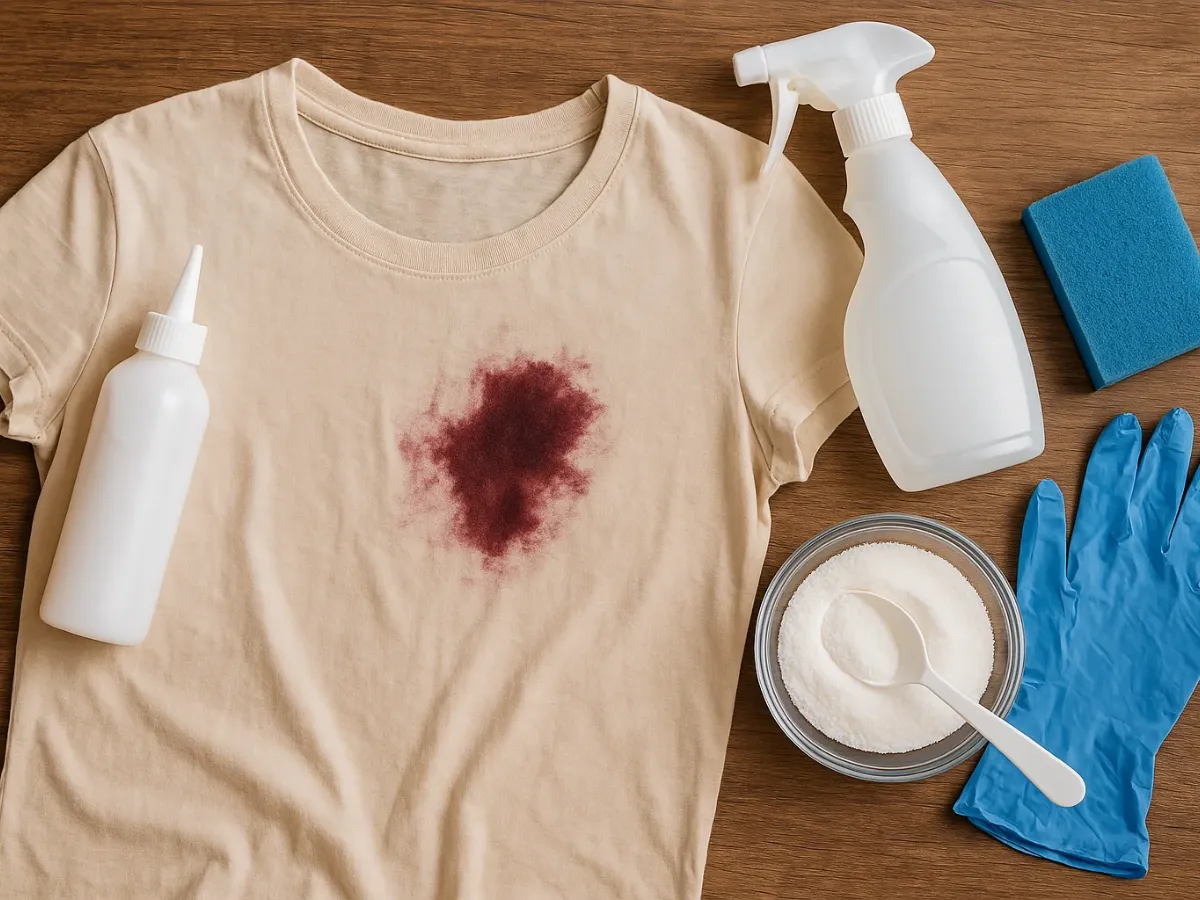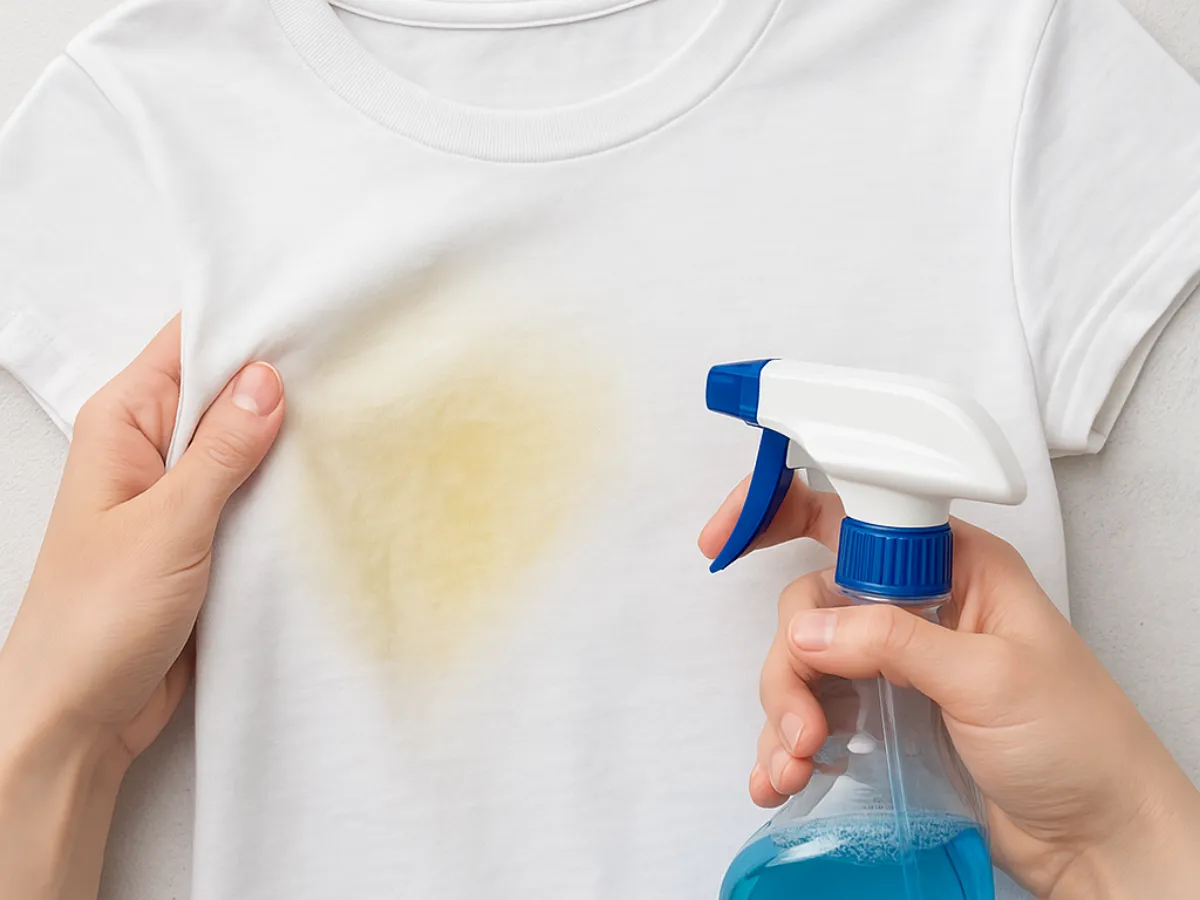Hair Disaster! How to Remove Hair Dye Stains from Clothes

Dyeing your hair at home is a convenient and affordable way to change your look or cover grays, but it also carries an inherent risk: the dreaded dye stains on clothes. A splash, a careless rub with the towel or shirt collar... and that dark, persistent stain seems to ruin the garment forever. Hair dyes are designed to be permanent and penetrate the hair fiber – and they do the same to textile fibers! But does that mean it's impossible to remove dye stains from clothes?
Not necessarily! Although they are tough stains, especially if they dry, there are several methods and products (homemade and commercial) that can help you eliminate or at least significantly fade these stains, on both white and colored clothing. The key, as always, is to act fast and use the right technique for the fabric.
Why Are Hair Dye Stains So Stubborn?
Hair dyes, especially permanent and semi-permanent ones, contain very small color molecules designed to penetrate the hair cuticle and fix inside through chemical reactions (often with peroxide and ammonia). This same penetration and fixing ability is what makes them so difficult to remove from fabrics:
- Deep Penetration: The dyes get between the fabric fibers.
- Chemical Fixation: The oxidation processes that fix the color in hair can also do so in clothes.
- Wash Resistance: They are designed to withstand numerous washes in hair, so a simple cycle in the washing machine is usually not enough.
Therefore, we need products that can dissolve, bleach, or chemically break down these dye molecules.
Immediate Action! The First Steps Are Vital
If dye has just landed on your clothes, every second counts:
- Remove Excess (Without Rubbing): If there's a blob of dye, use paper towel or a spoon to lift it very carefully, without pressing or spreading the stain.
- Blot (Without Rubbing): Gently press the stain with clean paper towels or a white cloth to absorb as much liquid dye as possible. Change the paper/cloth frequently.
- Rinse with COLD Water from the Back: Place the stained area under a strong stream of COLD water, letting the water run from the inside of the garment outwards. This helps flush out some dye before it penetrates further. Don't use hot water, it sets the color!
- Apply a Product Immediately: Don't let the stain dry. Proceed directly to apply one of the methods described below.
Effective Methods for Removing Dye Stains
The choice of method will depend on the fabric type, the color of the garment, and whether the stain is fresh or dry. Always remember to test any product on a hidden area before applying it to the main stain!
1. Isopropyl Alcohol (Rubbing Alcohol): The Versatile Solvent
This is often one of the first remedies to try, especially on fresh stains.
- How it Works: Alcohol helps dissolve and lift some of the dye components.
- Application: Place an absorbent white cloth under the stain. Moisten another clean white cloth or cotton ball with isopropyl alcohol (70% or 90%). Dab gently on the stain, working from the edges inward. Do not rub aggressively.
- Transfer: You'll see some dye transfer to the cotton ball and the cloth underneath. Change the cotton ball and the area of the cloth underneath frequently.
- Repetition: Continue applying and dabbing until no more dye transfers.
- Rinse and Wash: Rinse the area thoroughly with cold water and wash the garment immediately as usual.
- Caution: Test for colorfastness! It can affect some fabric dyes. Ventilate well.

2. Hairspray (with Alcohol): The Quick Trick
Similar to alcohol, but hairspray creates a film that sometimes helps encapsulate the dye.
- Type of Hairspray: Look for one with high alcohol content (basic ones usually have more).
- Application: Protect your work surface. Spray generously directly onto the fresh stain.
- Wait and Clean: Let it sit for a few seconds or a minute. Then, try blotting with a clean cloth or gently rubbing with an old toothbrush.
- Rinse and Wash: Rinse immediately with cold water and wash the garment.
- Effectiveness: Works best on very recent stains. May leave its own residue.
3. White Vinegar and Detergent: Mild Acidic Option
The acidity of vinegar can help break down some dye molecules.
- Preparation: Mix equal parts white vinegar and cold water. Alternatively, mix 1 tablespoon of vinegar and 1 tablespoon of liquid detergent in 1 liter (quart) of warm water.
- Soak or Direct Application: Submerge the stained area in the solution for 30 minutes or apply the mixture directly to the stain.
- Gentle Rubbing: Gently rub with a soft brush.
- Rinse and Wash: Rinse well and wash the garment.
- Caution: Colorfastness test is mandatory!
4. Very Diluted Ammonia: For Tough Cases (Use Extreme Caution!)
Ammonia is a powerful alkaline cleaner, but must be used very carefully.
- Safety First!: Wear gloves and work in a VERY well-ventilated area. Never mix ammonia with bleach.
- Dilution: Mix 1 part household ammonia with 10-15 parts COLD water. Never more concentrated!
- Mandatory Test: Essential to test in a hidden area, it can easily bleach colors.
- Application: Dampen a white cloth with the solution, wring it out well. Dab gently ONLY on the stain, without soaking.
- Quick Rinse: Don't let it sit long. Rinse immediately and thoroughly with cold water.
- Wash Afterwards: Wash the garment right away.
- Alternative: Mix 1 liter (quart) of warm water, 20ml (4 tsp) ammonia, and 20ml (4 tsp) liquid detergent, soak for 15 min, rub gently, and rinse.
Reserve this as a last resort for durable fabrics and solid colors (after testing).
5. Hydrogen Peroxide or Bleach (Only Whites & With Great Care!)
- Hydrogen Peroxide (3%): For durable white clothes. Soak a cotton ball and apply it to the stain. Let it sit for a few minutes (watching for yellowing or fiber damage). Rinse very well and wash.
- Bleach (Sodium Hypochlorite): ONLY for 100% cotton or linen white clothes that allow bleach (check label △). Dilute 1 part bleach in 15-20 parts cold water. Soak the garment for ONLY 5-10 minutes maximum. Rinse thoroughly and wash. More details in how to whiten with bleach.
6. Specific Commercial Stain Removers
There are products designed for tough stains or ink/color.
- Look for stain removers that indicate effectiveness against ink or dyes.
- Follow the manufacturer's instructions exactly (application, waiting time, washing).
- Always perform a colorfastness test!
What If the Dye Stain is Dry?
It's much harder, but not impossible. The steps are similar, but require more persistence:
- Scrape Gently: If there's a dry crust of dye, try to remove it carefully.
- Apply Product (Alcohol or Stain Remover): Isopropyl alcohol is still a good option. Apply it generously with a cotton ball to the dry stain and let it work longer (several minutes) to try and dissolve it. Press and change the cotton ball repeatedly.
- Soak (Optional): If the garment allows, a prolonged soak in cold water with detergent or a specific product can help soften the stain before treating it.
- Repeat: You'll likely need to repeat the solvent/stain remover application and washing several times.
- No Heat!: Remember not to dry the garment until the stain is gone.
Final Considerations
- Black Dye: Usually the hardest to remove. Persist with alcohol or consider specific products.
- Colored Clothes: Always prioritize the colorfastness test. Start with alcohol or diluted vinegar.
- Delicate Fabrics: If the garment is silk, wool, or very delicate, the safest option is to take it to a professional dry cleaner as soon as possible and explain the origin of the stain.
Also, if residue or halos remain after several attempts, it might be useful to consult guides on yellow stains or color bleeding.
Frequently Asked Questions about Dye Stains
How do you remove hair dye stains from clothes?
Quickly: remove excess, try isopropyl alcohol or hairspray by dabbing. Diluted vinegar or ammonia with caution. Bleach/hydrogen peroxide for whites.
How to get a dye stain out of clothes?
If it's hair dye, use the methods above. If it's accidental color bleeding, rewash alone in cold water or use a commercial color run remover.
What is good for removing dye from clothes?
Isopropyl alcohol, hairspray, vinegar, ammonia (diluted and tested), or specific stain removers.
How to remove dye from color-bled clothes?
These are different issues. For clothes bled by another garment, use a commercial color run remover. For hair dye stains, use alcohol, etc.
Hair dye stains are challenging, but with speed, the right products, and the correct technique (no rubbing!), you have a good chance of saving your clothes. Always remember to prioritize fabric safety and test before applying any chemical product.
Impossible Dye Stain? Professional Wash at LaColada!
Some dye stains, especially dried ones or on delicate fabrics, can be extremely difficult to remove at home. If you've tried everything without success, washing in the professional machines at LaColada Self-Service Laundry Ponferrada, with high-quality detergents and active oxygen, might be the solution to remove the last traces and bring your garment back to life.
Wash Your Clothes at LaColada Ponferrada!
Sebastián R.
More than 10 years at the helm of Lacolada Lavanderia Autoserivico Ponferrada and repairing industrial and domestic machinery in my spare time. You won't find unverified theories from the internet here, just real solutions tested by someone who gets their hands dirty every day.
Other Stain Removal Guides

Removing Paint Stains from Clothes (Water, Oil, Acrylic)
Complete guide to eliminating different types of paint.

How to Remove Yellow Stains (White & Colored Clothes)
Restore original brightness by eliminating yellowing.

How to Recover Clothes Affected by Color Bleeding
Solutions to remove color transfer stains.